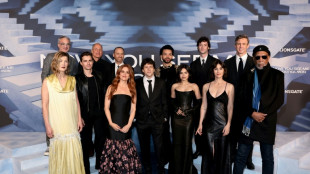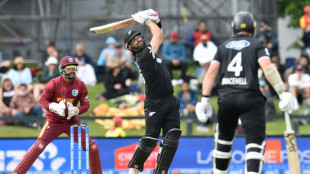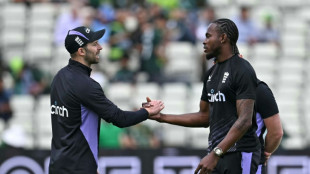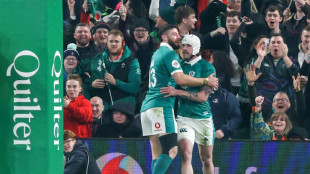
-
 'Now You See Me' sequel steals N. American box office win
'Now You See Me' sequel steals N. American box office win
-
Argentina beat Scotland after frenzied fightback

-
 Argentina beat Scotland after stunning fightback
Argentina beat Scotland after stunning fightback
-
Pope urges leaders not to leave poor behind

-
 Pressure will boost Germany in 'knockout' Slovakia clash, says Nagelsmann
Pressure will boost Germany in 'knockout' Slovakia clash, says Nagelsmann
-
Ecuador votes on hosting foreign bases as Noboa eyes more powers

-
 Portugal qualify for 2026 World Cup by thrashing Armenia
Portugal qualify for 2026 World Cup by thrashing Armenia
-
Greece to supply winter gas to war battered Ukraine

-
 India and Pakistan blind women show spirit of cricket with handshakes
India and Pakistan blind women show spirit of cricket with handshakes
-
Ukraine signs deal with Greece for winter deliveries of US gas

-
 George glad England backed-up haka response with New Zealand win
George glad England backed-up haka response with New Zealand win
-
McIlroy loses playoff but clinches seventh Race to Dubai title

-
 Ecuador votes on reforms as Noboa eyes anti-crime ramp-up
Ecuador votes on reforms as Noboa eyes anti-crime ramp-up
-
Chileans vote in elections dominated by crime, immigration

-
 Turkey seeks to host next COP as co-presidency plans falter
Turkey seeks to host next COP as co-presidency plans falter
-
Bezzecchi claims Valencia MotoGP victory in season-ender

-
 Wasim leads as Pakistan dismiss Sri Lanka for 211 in third ODI
Wasim leads as Pakistan dismiss Sri Lanka for 211 in third ODI
-
Serbia avoiding 'confiscation' of Russian shares in oil firm NIS

-
 Coach Gambhir questions 'technique and temperament' of Indian batters
Coach Gambhir questions 'technique and temperament' of Indian batters
-
Braathen wins Levi slalom for first Brazilian World Cup victory

-
 Rory McIlroy wins seventh Race to Dubai title
Rory McIlroy wins seventh Race to Dubai title
-
Samsung plans $310 bn investment to power AI expansion

-
 Harmer stars as South Africa stun India in low-scoring Test
Harmer stars as South Africa stun India in low-scoring Test
-
Mitchell ton steers New Zealand to seven-run win in first Windies ODI

-
 Harmer stars as South Africa bowl out India for 93 to win Test
Harmer stars as South Africa bowl out India for 93 to win Test
-
China authorities approve arrest of ex-abbot of Shaolin Temple

-
 Clashes erupt in Mexico City anti-crime protests, injuring 120
Clashes erupt in Mexico City anti-crime protests, injuring 120
-
India, without Gill, 10-2 at lunch chasing 124 to beat S.Africa

-
 Bavuma fifty makes India chase 124 in first Test
Bavuma fifty makes India chase 124 in first Test
-
Mitchell ton lifts New Zealand to 269-7 in first Windies ODI

-
 Ex-abbot of China's Shaolin Temple arrested for embezzlement
Ex-abbot of China's Shaolin Temple arrested for embezzlement
-
Doncic scores 41 to propel Lakers to NBA win over Bucks

-
 Colombia beats New Zealand 2-1 in friendly clash
Colombia beats New Zealand 2-1 in friendly clash
-
France's Aymoz wins Skate America men's gold as Tomono falters

-
 Gambling ads target Indonesian Meta users despite ban
Gambling ads target Indonesian Meta users despite ban
-
Joe Root: England great chases elusive century in Australia

-
 England's Archer in 'happy place', Wood 'full of energy' ahead of Ashes
England's Archer in 'happy place', Wood 'full of energy' ahead of Ashes
-
Luxury houses eye India, but barriers remain

-
 Budget coffee start-up leaves bitter taste in Berlin
Budget coffee start-up leaves bitter taste in Berlin
-
Reyna, Balogun on target for USA in 2-1 win over Paraguay

-
 Japa's Miura and Kihara capture Skate America pairs gold
Japa's Miura and Kihara capture Skate America pairs gold
-
Who can qualify for 2026 World Cup in final round of European qualifiers

-
 UK to cut protections for refugees under asylum 'overhaul'
UK to cut protections for refugees under asylum 'overhaul'
-
England's Tuchel plays down records before final World Cup qualifier

-
 Depoortere double helps France hold off spirited Fiji
Depoortere double helps France hold off spirited Fiji
-
Scotland face World Cup shootout against Denmark after Greece defeat

-
 Hansen hat-trick inspires Irish to record win over Australia
Hansen hat-trick inspires Irish to record win over Australia
-
Alcaraz secures ATP Finals showdown with 'favourite' Sinner

-
 UK to cut protections for refugees under asylum 'overhaul': govt
UK to cut protections for refugees under asylum 'overhaul': govt
-
Spain, Switzerland on World Cup brink as Belgium also made to wait


The tsunami detection buoys safeguarding lives in Thailand
Almost 1,000 kilometres off the Thai coast devastated by a tsunami 20 years ago, engineers lower a detection buoy into the waves -- a key link in a warning system intended to ensure no disaster is as deadly again.
On December 26, 2004, a magnitude 9.1 earthquake under the Indian Ocean triggered a huge tsunami with waves up to 30 metres (100 feet) high.
Only a rudimentary warning system was in place at the time, with no way to alert the millions of people living around the Indian Ocean in advance. More than 225,000 people were killed in a dozen countries.
In the years following the disaster, multiple governments developed a global tsunami information system, building on the US National Oceanic and Atmospheric Administration's (NOAA) network of six detection buoys in the Pacific.
Known as Deep-Ocean Assessment and Reporting of Tsunamis (DART), the system now has 74 buoys around the world.
Each floats on the surface while tethered to the seabed, monitoring signals from a seismic sensor on the ocean floor and changes in the water level.
Installed in some of the toughest working environments anywhere on the planet, the battery-powered buoys must be replaced every two years. Only 50 of the devices are currently operational but the network has been designed to provide coverage regardless.
The Thai research vessel M.V. SEAFDEC crew gently lowered a replacement buoy -- a yellow cylinder about two metres in diameter -- this month into the Indian Ocean 965 kilometres (600 miles) offshore.
- Five-minute warning -
The same team also sought to replace a closer buoy in the Andaman Sea, 340 kilometres from the coast, but were unsuccessful and will mount a new mission in the coming weeks.
Shawn Stoeckley, a mechanical engineer from buoy manufacturers Science Applications International Corporation (SAIC), calibrates the system from his laptop on board before it is deployed.
"I feel that it has a lot of purpose, that it can save coastal lives," he told AFP.
The 2004 tsunami killed more than 5,000 people in Thailand, according to official figures, with 3,000 missing.
Now the country's two DART buoys are linked by satellite to a nationwide network of 130 alarm towers equipped with sirens and loudspeakers that can broadcast in five languages in coastal provinces.
Residents in disaster-prone areas also receive an SMS alert of an imminent tsunami, warning them to evacuate quickly.
Before 2004, it would take anywhere from 15 to 50 minutes before an alarm could be issued, says Laura Kong, director of UNESCO's International Tsunami Information Center.
"Today it's typical we would get something within five to seven minutes," she said.
One day, say UN experts, the system will prove essential.
There is a "100 percent chance" of another tsunami on the scale of 2004 at some point, Bernardo Aliaga, UNESCO's head of Tsunami Resilience Section, told an anniversary conference, adding it "could be tomorrow or in 50 years or 100 years".
- False alarms -
Mobile phones have become ubiquitous and disaster apps widely available in the years since the tsunami, but locals say the towers are still vital.
Songsil Nodharith, 51, head of Khuek Khak village, helped residents to evacuate "without even grabbing their belongings" during a night-time false alarm last year and urged authorities to ensure that the towers were well maintained.
In Sri Lanka -- where 31,000 were killed in 2004, making it the second-worst-hit country -- more than three-quarters of the 77 tsunami warning towers the government subsequently installed are not operating because the communications equipment has become obsolete, the island's Disaster Management Centre chief Udaya Herath told AFP.
Mobile phone companies have instead identified some 70,000 "key contacts" in coastal areas, including resort managers, to receive warnings and evacuation orders in the event of impending danger.
Warnings have occasionally set off panic in Thailand, with locals and tourists rushing for higher ground, but residents have faith in the system.
The fishing village of Ban Nam Khem saw Thailand's worst destruction in 2004, with trawlers swept onto houses and 800 residents killed.
Manasak Yuankaew, 48, now head of the village, lost four members of his family that day.
"We have a saying here," he told AFP. "Fleeing 100 times is better than not fleeing that one crucial time."
H.Darwish--SF-PST




